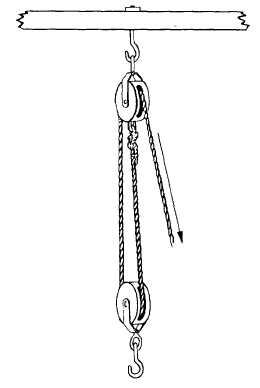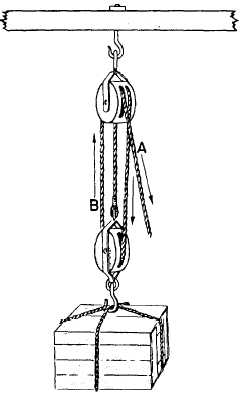Figure 2-6.-A gun tackle.
The single movable block in this setup is a
second-class lever. See figure 2-5. Your effort (E) acts
upward upon the arm (EF), which is the diameter of the
sheave. The resistance (R) acts downward on the arm
(FR), which is the radius of the sheave. Since the
diameter is twice the radius, the mechanical advantage
is 2.
When the effort at E moves up 2 feet, the load at R
is raised only 1 foot. That’s something to remember
about blocks and falls—if you are actually getting a
mechanical advantage from the system. The length of
rope that passes through your hands is greater than the
distance that the load is raised. However, if you can lift
a big load with a small effort, you don’t care how much
rope you have to pull.
The sailor in figure 2-4 is in an awkward position to
Figure 2-7.-A luff tackle.
want to get. For example, a luff tack consists of a double
block and a single block, rigged as in figure 2-7. Notice
that the weight is suspended by the three parts of rope
that extend from the movable single block. Each part of
the rope carries its share of the load. If the crate weighs
600 pounds, then each of the three parts of the rope
supports its share—200 pounds. If there’s a pull of 200
pounds downward on rope B, you will have to pull
downward with a force of 200 pounds on A to
counterbalance the pull on B. Neglecting the friction in
the block, a pull of 200 pounds is all that is necessary to
raise the crate. The mechanical advantage is:
pull. If he had another single block handy, he could use
it to change the direction of the pull, as in figure 2-6.
This second arrangement is known as a gun tackle.
Because the second block is fixed, it merely changes the
direction of pull—and the mechanical advantage of the
Here’s a good tip. If you count the number of parts
of rope going to and from the movable block you can
whole system remains 2.
figure the mechanical advantage at a glance. This simple
You can arrange blocks in several ways, depending
rule will help you to approximate the mechanical
on the job to be done and the mechanical advantage you
advantage of most tackles you see in the Navy.
2-3




